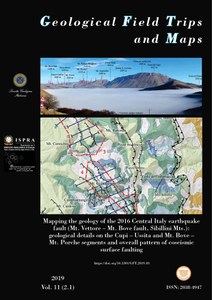Mapping the geology of the 2016 Central Italy earthquake fault (Mt. Vettore – Mt. Bove fault, Sibillini Mts.): geological details on the Cupi – Ussita and Mt. Bove – Mt. Porche segments and overall pattern of coseismic surface faulting
We present the results of a field survey performed in the centralnorthern portion of the Mt. Vettore – Mt. Bove normal fault (VBF), reactivated during the 2016 central Italy earthquake sequence (24 August, Mw 6.0; 26 October Mw5.4 and Mw 5.9; 30 October Mw 6.5). The field survey was carried out by means of digital mapping techniques, and traditional methods on 1:10,000-scale topographic maps. The field work had two main aims: 1) to detail the geology of the central-northern VBF, and to constrain the segmentation and displacement distribution of the entire VBF system; and 2) to map in detail the ruptures of the 26 and 30 October events, filling in the gaps left by previous studies, and provide constraints on the coseismic parameters of the 2016 earthquakes. The results are summarized in a composite geological map, organized in 8 frames showing: the structural architecture in map view of the VBF system (frames 1 and 2); 1:25,000-scale geological maps of the Cupi-Ussita (frame 3) and Mt. Bove – Mt. Porche (frame 4) sectors of the VBF; twelve 1:25,000-scale geological sections for computing the geological displacements (frame 5); a summary of the coseismic parameters of the 2016 earthquakes (diagrams of net displacement, throw and opening; Surface Rupture Length, SRL; Maximum Displacement, MD and Average Displacement, AD) (frame 6); a comparison of the 2016 coseismic parameters with normal faulting earthquakes occurred globally (frame 7); and a computation of the morphological displacement (post-Last Glacial Maximum, LGM) across the VBF, a comparison among geological, morphological and coseismic displacements, and a quantification of the tectonic back-tilting in the area of maximum coseismic displacement (frame 8). Some implications are discussed in this accompanying note, such as the role of fault segmentation deduced from structural geology and tectonic geomorphology in controlling the coseismic displacement, the role of back-tilting in amplifying the coseismic displacement and the limits of empirical regressions in predicting the relations between rupture parameters and Mw in case of segmented normal faults.
https://doi.org/10.3301/GFT.2019.03

